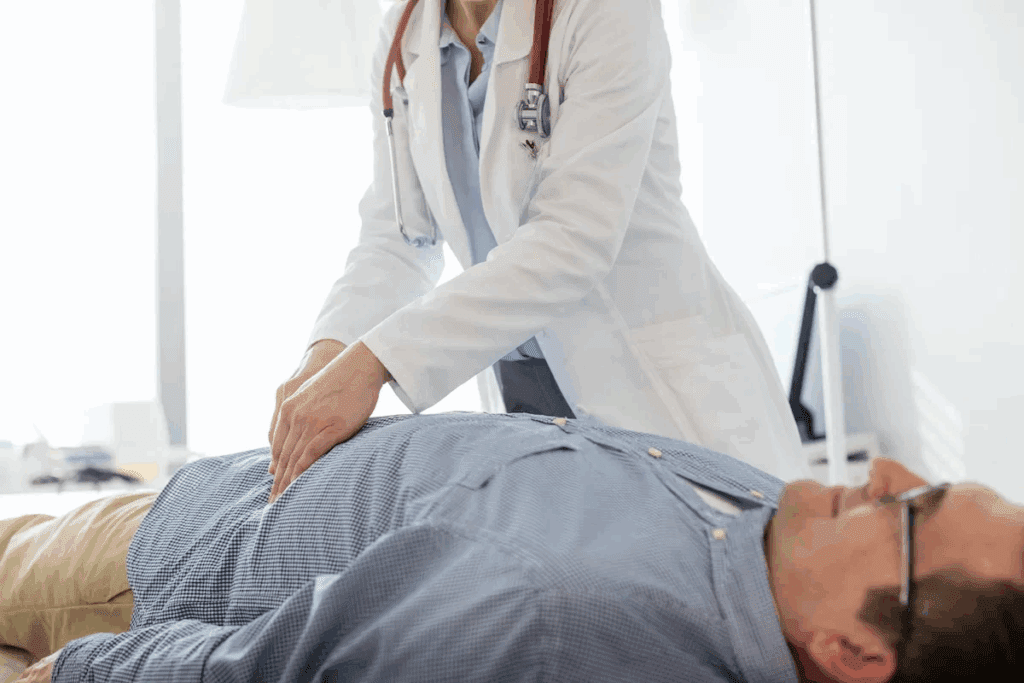Last Updated on November 26, 2025 by Bilal Hasdemir

Explore 8 key umbilical hernia symptoms in adults and surgical options for effective treatment.
A bulge near the belly button is more than a cosmetic issue for adults. It might signal an adult umbilical hernia, a condition needing medical help.
Umbilical hernias happen when part of the intestine bulges through an opening in the abdominal muscles. Adults with this issue often feel pain or discomfort, mainly when straining, lifting, or coughing.
Liv Hospital focuses on treating adult umbilical hernias with care, including surgery. Knowing the symptoms and treatment helps adults get the right care they need.

An umbilical hernia is a condition in adults where a bulge appears near the navel. This happens because of a weak spot in the abdominal wall. It occurs when part of the intestine or tissue pushes through a weak area in the abdominal muscles near the navel.
Umbilical hernias happen when intestine or tissue bulges through a weak spot in the abdominal muscles near the navel. The mechanism behind this condition involves a mix of factors. These include increased abdominal pressure and a congenital or acquired weakness in the abdominal wall.
“The risk factors for umbilical hernias include obesity, pregnancy, and chronic coughing or straining, all of which increase abdominal pressure.”
Medical Expert
The area near the navel is more likely to herniate because of its anatomy. The navel is a natural weak spot where the abdominal wall is thinner. This makes it more prone to herniation under stress.
Umbilical hernias are common in adults, more so in certain groups. Studies show that obesity, pregnancy, and chronic coughing or straining increase the risk. Adults with these conditions are more likely to get an umbilical hernia.
The frequency of umbilical hernias in adults varies. But they are more common in some groups. For example, men are more likely than women to get them. People with a history of abdominal surgery or chronic conditions that raise abdominal pressure are also at higher risk.

Knowing the signs of an umbilical hernia is key to better treatment. Adults with umbilical hernias show different symptoms. These symptoms can affect daily life in various ways.
A bulge at the navel is a common sign. It gets bigger when you cough, strain, or stand up. Doctors say a bulge is often the first thing people notice and seek help for.
Pain around the navel is another important symptom. This pain can be mild or severe. It might feel like a dragging sensation or heaviness.
Some people feel a burning or aching around the umbilicus. This feeling gets worse with activities that put pressure on the belly, like heavy lifting or bending.
Straining the belly muscles, like with heavy lifting or straining during bowel movements, can make pain worse. Knowing these symptoms helps avoid serious problems.
Other signs include nausea or vomiting if the hernia gets worse. Spotting these symptoms early helps get the right treatment sooner.
Knowing what can lead to umbilical hernias is key to preventing and treating them. Many things can weaken the abdominal wall, making hernias more likely.
Studies show umbilical hernias are more common in men. The exact reasons for this gender disparity are not fully understood. Hormonal and physiological differences might play a part. Men are more likely to get umbilical hernias due to higher intra-abdominal pressure and muscle structure differences.
Being overweight is a big risk factor for umbilical hernias. Excess weight strains the abdominal wall, increasing pressure inside. This weakens muscles around the navel, making hernias more likely. Big weight changes also strain muscles, increasing hernia risk.
Pregnancy is a big risk factor for umbilical hernias. The pressure inside the belly during pregnancy weakens the abdominal wall, mainly around the navel. Women with multiple pregnancies are at higher risk due to repeated muscle strain. Proper prenatal care and post-pregnancy follow-up can help identify issues early.
Chronic coughing or straining can also lead to umbilical hernias. Conditions like COPD or other respiratory issues cause persistent coughing, increasing belly pressure. Activities that involve heavy lifting or straining also stress the abdominal wall, raising hernia risk.
By knowing these risk factors, people can take steps to prevent umbilical hernias. If symptoms appear, seeking medical help is important. Early detection and treatment are key to managing umbilical hernias well.
Umbilical hernias come in different types, like primary, paraumbilical, and massive. Knowing these types helps doctors diagnose and treat them right.
Primary umbilical hernias happen through the umbilical ring, near the belly button. They’re more common in adults with extra belly fat or chronic coughing. Symptoms include a bulge at the belly button and pain when lifting heavy things.
Paraumbilical hernias are near the belly button but not through it. They’re more common in women. Symptoms are similar to primary hernias, like pain around the belly button. If not treated, they can get stuck or cut off blood flow.
Massive umbilical hernias are big and can hold a lot of the belly’s contents. They’re at higher risk for serious problems. Surgery is usually needed to fix them and prevent more issues.
In summary, knowing about umbilical and paraumbilical hernias is key for good treatment. Each type has its own signs and risks. This shows why getting the right diagnosis and care is so important.
Untreated umbilical hernias can lead to serious health issues. They can even be life-threatening. Not treating a hernia can cause many problems that affect your quality of life and health.
A non-reducible or incarcerated umbilical hernia happens when tissue gets trapped. It can’t be pushed back into the belly. This causes a lot of pain and discomfort.
If the hernia gets stuck, it can block the intestine. This cuts off blood to the intestine.
Incarceration raises the risk of strangulation. It’s important to watch the hernia and get medical help if symptoms get worse or if you see signs of incarceration.
Strangulation is when the blood supply to the intestine is cut off. This can cause tissue death, infection, and serious health issues. Bowel obstruction happens when the intestine is blocked, stopping normal bowel movements.
Symptoms of strangulation and bowel obstruction include severe pain, nausea, vomiting, and constipation. These need immediate medical attention to avoid further damage and death.
Get emergency medical care if you have severe abdominal pain, vomiting, fever, or if the hernia is tender or discolored. These signs might mean the hernia is strangulated or incarcerated.
Prompt medical intervention can greatly improve outcomes and prevent serious problems. If you’re experiencing severe symptoms, don’t wait to get help.
Diagnosing umbilical hernias in adults requires a mix of clinical checks and tests. A detailed diagnostic process is key to spotting an umbilical hernia and finding the right treatment.
A physical check is usually the first step in finding an umbilical hernia. A healthcare provider will look for a bulge or swelling near the belly button. They might ask the patient to cough or strain to see the hernia better.
Key parts of the physical check include:
Even with a physical check, imaging tests might be needed in some cases. These tests confirm the diagnosis and check for other possible causes of symptoms.
| Imaging Test | Purpose |
| Ultrasound | To see the hernia and what’s inside it |
| CT Scan | To measure the hernia size and look for complications |
| X-ray | To find out if there’s a bowel blockage or other issues |
Differential diagnosis is a big part of the diagnostic process. It’s about ruling out other conditions that could look like an umbilical hernia. Things like diastasis recti or tumors need to be considered.
A complete diagnostic check ensures patients get the right diagnosis and treatment for their problem.
Non-surgical methods are key in treating adult umbilical hernias. They are great for those who don’t need surgery right away or prefer not to have it. These methods can help manage symptoms without surgery.
Watchful waiting means keeping an eye on the hernia for any changes. It’s good for small, painless hernias. Regular doctor visits are important to catch any problems early.
Changing your lifestyle can help with umbilical hernia symptoms. Staying at a healthy weight is important. It helps avoid putting too much pressure on the hernia.
Also, avoid heavy lifting and straining when you go to the bathroom. This helps keep the pressure off the hernia.
Lifestyle Changes for Hernia Management:
| Lifestyle Modification | Benefit |
| Maintaining a healthy weight | Reduces strain on the abdominal wall |
| Avoiding heavy lifting | Decreases pressure on the hernia |
| Eating a high-fiber diet | Reduces straining during bowel movements |
For those in pain from their hernia, there are ways to manage it. Doctors might suggest over-the-counter pain meds. Sometimes, special clothes or devices can help with pain and support.
It’s important for patients to talk to their doctor about the best non-surgical plan. By using watchful waiting, lifestyle changes, and pain management, many can manage their symptoms well. This improves their quality of life.
Surgery is often the best way to treat adult umbilical hernias. It’s key for those with symptoms or at risk of complications. The goal is to fix the hernia, ease symptoms, and stop it from coming back.
There are two main ways to fix umbilical hernias: open and laparoscopic surgery. Open surgery makes one big cut near the hernia to repair it. It’s good for smaller hernias.
Laparoscopic surgery uses small cuts and a camera to fix the hernia. It usually means less pain and faster healing than open surgery.
Choosing between open and laparoscopic surgery depends on the hernia’s size and the patient’s health. Both have pros and cons. Talking to a doctor helps decide the best option.
Mesh reinforcement adds support to the weak area in hernia repair. The mesh is made from synthetic or biological materials. Mesh placement can be open or laparoscopic. Mesh helps prevent the hernia from coming back.
There are different ways to place the mesh, like onlay, inlay, and underlay. The choice depends on the hernia and the surgeon’s preference. Mesh is great for bigger hernias or those with more weakness.
Small umbilical hernias might be fixed with suture repair. This method uses stitches without mesh. It’s good for small hernias with little weakness. But, it might not work as well for bigger hernias.
Massive umbilical hernias need special surgery because of their size. They might use big meshes or other materials. Component separation techniques help close the abdominal wall without tension. Sometimes, plastic surgery is needed for the best results.
Choosing the right surgery for adult umbilical hernias depends on many factors. A doctor’s advice is key to finding the best treatment.
Recovering well after umbilical hernia surgery is key to success. A good recovery plan helps manage pain and lowers infection risk. It also makes getting back to normal life faster.
Right after surgery, care is critical. Follow your doctor’s advice on wound care, pain, and meds. Keeping the surgical site clean and dry stops infections. Pain is managed with meds and rest.
Watch for infection signs like redness, swelling, or fever. Know the signs of serious problems like severe pain or vomiting. Get help right away if you see these.
Staying active but careful is important. Avoid heavy lifting, bending, or hard work for weeks. Slowly start moving more to avoid problems and help healing.
Eating well helps you heal. Eat lots of fruits, veggies, and protein. Drink plenty of water too.
Surgery is mostly safe, but watch out for infections, adhesions, and hernia coming back. Stick to your doctor’s advice to lower these risks.
How often a hernia comes back depends on the surgery and if mesh is used. Mesh helps a lot in preventing recurrence.
Knowing how to recover and following your doctor’s advice can greatly improve your surgery outcome.
It’s important to know the symptoms and treatment options for umbilical hernias. Recognizing signs like a visible bulge at the navel and pain can lead to seeking medical help. This is the first step in getting the right care.
Knowing the risk factors, like obesity and chronic coughing, helps prevent umbilical hernias. Treatment choices include watchful waiting, lifestyle changes, and surgery. Talking to a healthcare professional helps decide the best treatment.
Understanding umbilical hernias and their treatments is key to making good decisions. Consulting a healthcare professional ensures the best treatment for each person. This improves their quality of life.
Symptoms include a visible bulge at the navel. You might also feel pain or discomfort around the umbilicus. A burning or aching sensation can occur, often when straining, lifting, or coughing.
An umbilical hernia happens when part of the intestine or tissue bulges through a weak spot in the abdominal muscles near the navel. This is often due to obesity, pregnancy, or chronic coughing.
Umbilical hernias are more common in men. This is because of differences in abdominal wall strength and the presence of other health conditions.
Yes, keeping a healthy weight, avoiding heavy lifting, and managing chronic coughing can help reduce symptoms and prevent complications.
Not treating umbilical hernias can lead to serious complications. These include non-reducible hernias, strangulation, and bowel obstruction. These can be life-threatening if not treated promptly.
Diagnosis involves a physical examination to check for a bulge near the navel. Imaging tests may also be used to confirm the diagnosis and rule out other conditions.
Surgical options include open and laparoscopic techniques. These may involve mesh reinforcement or suture repair, depending on the size and complexity of the hernia.
Recovery involves immediate post-operative care and activity restrictions. Follow-up appointments are also important to monitor healing and prevent complications.
Yes, there is a risk of recurrence. But using mesh reinforcement and following post-operative instructions can help minimize this risk.
Seek emergency care if you experience severe pain, vomiting, or signs of strangulation. This includes a discolored or tender bulge.
Watchful waiting and lifestyle modifications may be suitable for small, asymptomatic hernias. But surgical repair is often recommended for symptomatic or complicated cases.
Primary umbilical hernias occur directly at the navel. Paraumbilical hernias occur near the navel, often with different symptoms and characteristics.
Pietrangelo, A. (2024). Managing weight loss after gallbladder removal. Medical News Today. Retrieved from
Subscribe to our e-newsletter to stay informed about the latest innovations in the world of health and exclusive offers!